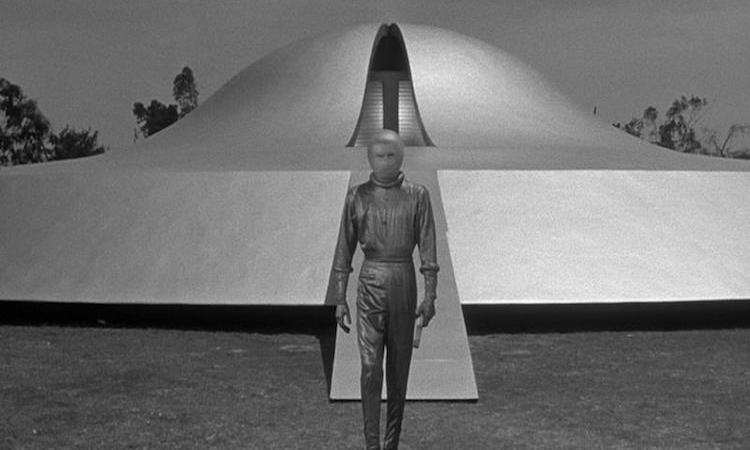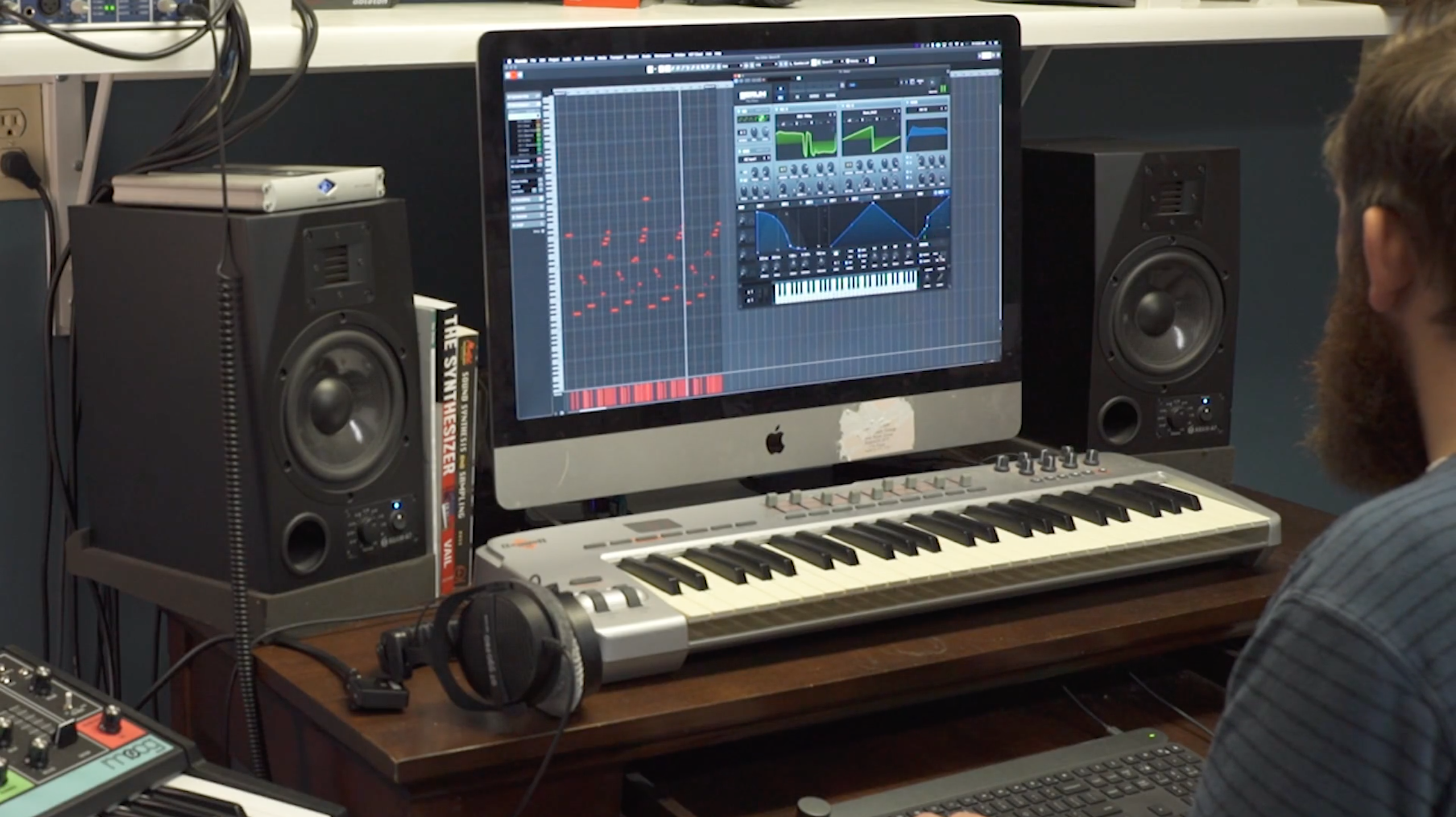+ Soundfly’s Intro to Scoring for Film & TV is a full-throttle plunge into the compositional practices and techniques used throughout the industry, and your guide for breaking into it. Preview for free today!
We live in the most exciting time one could possibly hope to be alive. Every day, new aspects of our earthly existence are being discovered, advanced, and technologically exploited to further improve our experience of reality on this planet and in this universe we humbly occupy. Yet, despite these fascinating daily occurrences, we still love to speculate on what could come next, in both the near and distant future. As such, the pinnacle of future-predictive media and art is, of course, science fiction films.
All right, wait one minute before all you novel-loving, paper-lugging tree-killers out there throw me under the flying bus about the nature of imagination associated with books. I love books! I do. But bear with me here… the kitsch involved in distilling an era’s singular idea of the future through present day technology manages to both give context to the collective vision of the future, and archive each era at the same time.
One of the ways we have explored the unknowable future is by speculating upon the sounds of the future. As I’m sure you know, many of these sounds are remarkably cheesy (Is that really what “beaming me up” sounds like? This laser looks more powerful than it sounds… etc.), but some of these sounds have gone on to define our understanding of certain technologies — a few of which have gone on to be realized!
One of the more obtuse but interesting uses of technology in sci-fi film is how quickly we adopted synthesized sounds into our vision of the future, since they represent the obvious sound of the future. Let’s take a look at the ways our use of synthesizers has developed throughout the history of forward-looking film.
But first, don’t forget to check out Soundfly’s online course, Advanced Synths and Patch Design for Producers, and learn how to move beyond presets to create a wide array of scintillating synth sounds for your productions.
The First Electronic Instruments in Film
Electronic music in film arguably began with the use of theremin, as exemplified in the classic extraterrestrial visitation film The Day the Earth Stood Still (1951). In Bernard Herrmann’s score, the instrument is set atop a largely orchestral score typical of the era, with a wide vibrato that, at times, makes the sound difficult to distinguish from an open-vowel vocal from a soprano opera singer.
Still, the use of the instrument begat our fascination with representing the otherworldly (i.e., aliens, UFOs, and other extraterrestrial concepts) with markedly otherworldly sounds.
Synthesizers as the Source of the Score
Forbidden Planet (1956) was the first film based entirely in outer space, making it one of the most extensive forays into science fiction filmmaking to that point. To go along with its exploration of the unknown, its score, written by Bebe and Louis Barron, was the first soundtrack consisting entirely of electronic sounds.

At the time, it couldn’t even be considered a “score” because its composers were not unionized musicians, and was instead dubbed a series of “electronic tonalities.” So, the Barrons could not be considered for Oscar nomination in the score or special effects categories.
The film traverses many soundscapes now considered classic sci-fi synthesized sounds — beeps, bloops, hums, buzzes, and whistles all run through varying degrees of spring reverb and delay effects to emphasize their “spaciness.” Even the topic of the film itself explores the futuristic and otherworldly nature of electronic sounds, as seen in this excerpt:
Forbidden Planet’s soundtrack set the (sound) stage for many future generations of sci-fi creators such as Star Trek creator Gene Roddenberry. The Barrons would continue to collaborate with filmmakers through the 50s, further developing their signature “tonalities.” Still, it would be many years before synthesizers would become widely available, and recognized as the standard sound of sci-fi. Electronic tones, though they defined much of the sci-fi sound in the early-to-mid fifties, would largely fall out of fashion and take a backseat to more jazz-oriented sounds through much of the early 60s, such as those found in the Planet of the Apes films.
The Rise of the Synthesized Behemoth
Yes, the mid-to-late 60s brought us the first round of synthesizers as we know them today — vast keyboards of knobs and blips and blinking meters, or imposing, maniacal walls of inputs and outputs covered in the same knobbery and mad-science nonsense. Robert Moog flooded the world with a new wave of commercially available synths into the ‘70s and redefined what we think of as the “sound of the future” — largely, an amalgamation of basic sonic waveforms, orchestrated in any way imaginable.
A Clockwork Orange (1971)
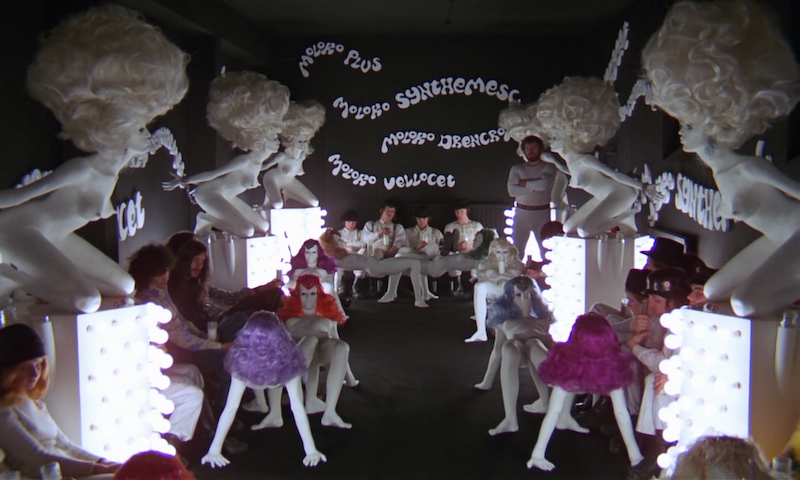
In 1971 Wendy Carlos wowed and confused and creeped out audiences by accompanying Kubrick’s eerie masterpiece, A Clockwork Orange, with synth- and vocoder-heavy arrangements of classical pieces. In so doing, Carlos masterfully ties in the psychological drama of Beethoven’s works, critical to the plot of the film, and adds another associative layer to the future-synths connection.
Halloween (1978)
Though not a sci-fi piece, Halloween still represents an important synth-based score of the era. In this classic thriller, director John Carpenter masterfully takes on the work of scoring his own film, using synth pads, basses, stabs, and electronic percussion to elevate a creepy piano-driven main-title theme. The harkening of ’80s synth-pop is readily apparent in this orchestration. John Carpenter would go on to score many of his own films, including The Fog, Escape from New York, and future installments in the Halloween series, among others.
Giorgio Moroder Takes Over
Disco and techno pioneer Giorgio Moroder’s contribution to synth scoring cannot be overstated. His utilization of extensive disco-dance beats in brilliant scores for such non-sci-fi hits as Midnight Express, American Gigolo, Scarface, Top Gun and the 1984 revitalization of Metropolis, as well as others, helped usher in a new wave of film music. And unlike his 50s predecessors, Moroder has won several Oscars.
The ’80s and Beyond
The renaissance of synthesized sci-fi scores, and potentially its golden era, truly came to in the ‘80s. By this point synthesizers had become fairly mainstream and were included in much of the chart-topping popular music of the age. But that didn’t stop composers from continuing to turn to these robotic music-makers for their futuristic needs.
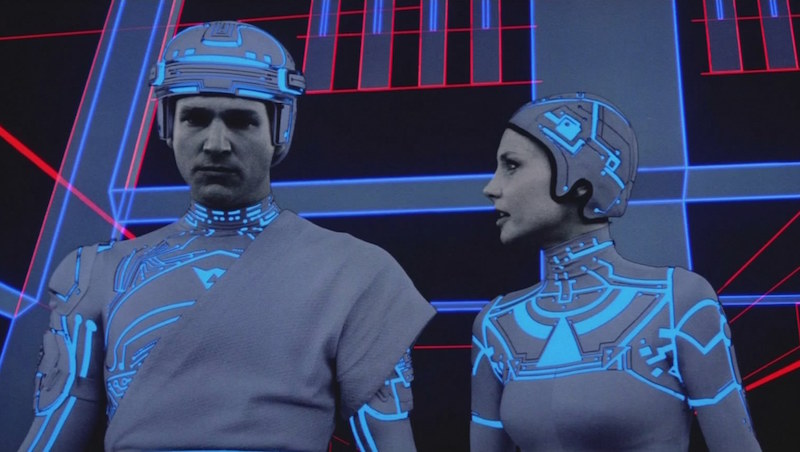
Wendy Carlos would again propel the frontier of electronic scoring forward with her innovative 1982 score for TRON, an indelible commentary on our likely dystopian future ruled by computers. Requiring menace and tension with a technological focus, synths provide an obvious palette for Carlos’ melodramatic orchestrations.
Then Bladerunner sank the future-focus of synth sounds even deeper into popular psyche. In this highly period-specific soundtrack, Vangelis followed up the success of his synth and drum machine-based soundtrack for Chariots of Fire (1981) with an even-synth-heavier soundtrack to augment the oppressively dystopian future portrayed. Unmistakably ‘80s production, paired with sweeping orchestral strings help mark this very specific era of synthesized scoring.
By that point, the ‘80s sci-fi synthesis scene had burst wide open, accompanying a similar trend in popular music. The terrifying return of John Carpenter with The Thing; the glitchy, bit-crunchy eeriness of Videodrome; the essentially epic, synth-orchestral fusion of The Terminator and its sequels; and many others sanctified synths as the standard for sci-fi scenarios, especially those of the creepy and unknown variety.
It is worth noting, that at this point during the height of synthesized scoring, many of the world’s most beloved sci-fi films chose to separate their sci-fi sound design, opting for a traditional orchestral arrangement and instrumentation. Some most notable examples of this include 2001: A Space Odyssey, Star Wars, Aliens, and Star Trek.
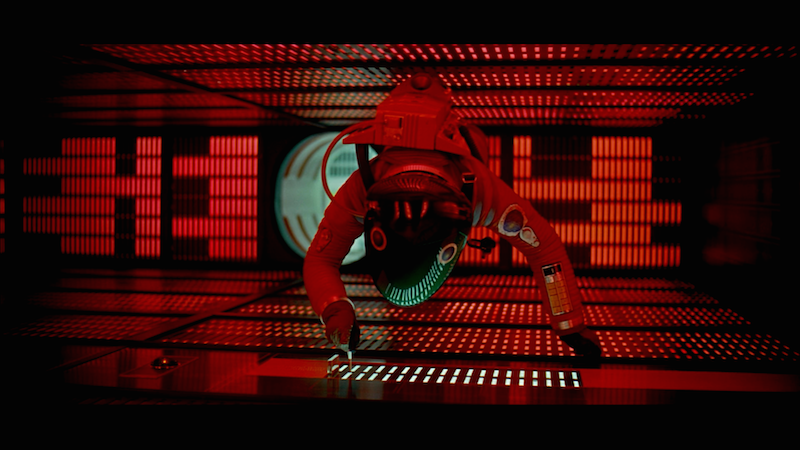
Many of the best known sci-fi films of the ‘90s followed in the footsteps of these earlier orchestra-only examples (Jurassic Park, Gattaca, Galaxy Quest, 12 Monkeys, etc.), but while popular rock and grunge music brought on a cultural rejection of the world of synthesis, a few soundtracks chose to embrace the sci-fi sonic legacy of synthesis and push forward.
Among the most significant were those dealing with the newest repercussions of digital computing technology. In 1995, Hackers, based largely on an underground scene of technologists undermining the status quo, chose to complement the story with underground rave music, including The Prodigy’s “Voodoo People”, side by side with early ‘90s dance music hits — a trend which Trainspotting would follow a year later (though neither compare to the brazen, lavish rave-life depiction of Cool World, from 1992). Cult-classic Tank Girl contains mainly grunge and punk, but the Courtney Love-compiled soundtrack also includes such electronic luminaries as Björk and Portishead.
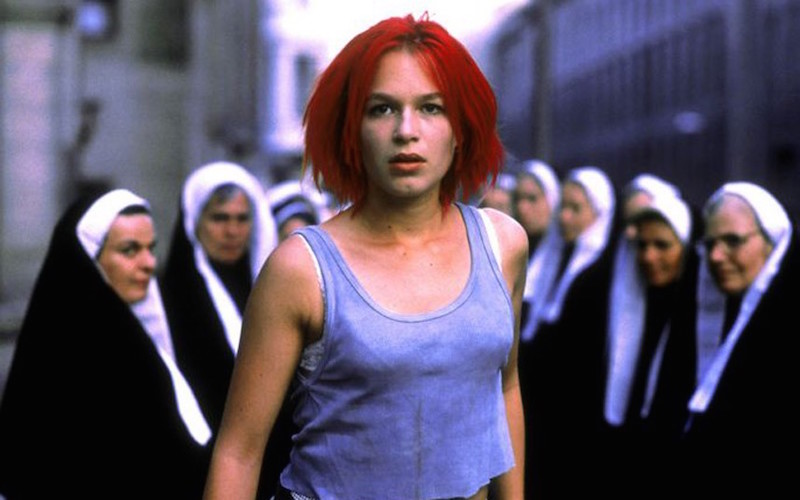
At the tail end of the ‘90s, many films full embraced the current electronic music of the time. The surrealist film Pi thrilled and chilled us with thumping IDM beats and trip-hop moods, The Matrix series would blow us away with its depiction of future worlds nestled within worlds accompanied by high-energy breakbeats. The thriller Run Lola Run took a similar approach, scored largely John Carpenter-style by its director, Tom Tykwer. And the trend continued well into the early 2000s.
Synths in Film Today
Today, of course, synths pervade much of film’s sonic landscape, though frequently still in tandem with classical, romantic orchestral writing.
Many contemporary composers such as Hans Zimmer (Inception, The Dark Knight Rises, Interstellar, and over 100 more), Junkie XL (300: Rise of an Empire, Paranoia, Mad Max: Fury Road), Bear McCreary (Battlestar Galactica, The Walking Dead), and others eloquently realize epic, devastating fusions of electronic and acoustic sounds where the audience frequently cannot distinguish between the two sonic realms.
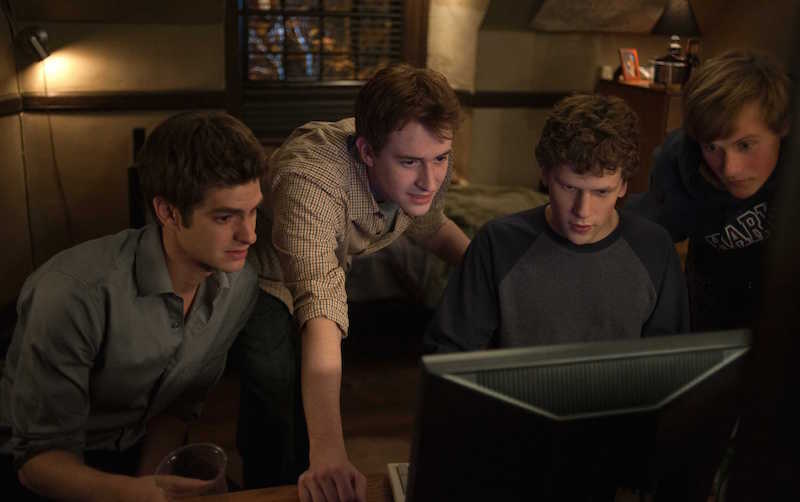
Meanwhile, artists like Trent Reznor and Atticus Ross (The Social Network, Gone Girl), Jon Hopkins (The Lovely Bones, Monsters), and others are working in an almost entirely synth-driven and electronic musical context, creating even more otherworldly sounds than the world has previously heard. Still, neither of these two approaches can be ruled out.
In other words, it’s an exciting time to be a music technology nerd. Composers working both with purely electronic scores, as well as those employing electronic elements within traditional, orchestral scores, all continue to redefine the sound of our collective future.
Additional Resources:
- “17 Sci-Fi Movies Every Guy Should See” — Cool Material
- “The Synthesizer: Modernist and Technological Transformations in Film Sound and Contemporary Music” — Dusin J. Green, Claremont McKenna College
- “The story behind the creation of the lasergun sound in Star Wars” — FilmSound.org
- “The First Electronic Filmscore-Forbidden Planet: A Conversation with Bebe Barron” — Effectrode
- “Secret Circuits: New York’s Early Electronic Music Mavericks” — Red Bull Music Academy
Have you checked out Soundfly’s courses yet?
Continue your learning with hundreds of lessons by boundary-pushing, independent artists like Kimbra, Ryan Lott & Ian Chang (of Son Lux), Jlin, Elijah Fox, Kiefer, Com Truise, The Pocket Queen, and RJD2. And don’t forget to try out our intro course on Scoring for Film & TV.
